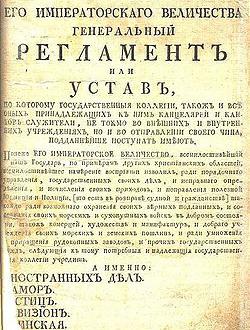With the development and strengthening of statehood in the Russian Empire, it was necessary to create a clear structure of public administration, which should be based on uniform principles of office work. Peter the Great as a reformer king simply could not help but create such a document as the General Rules.
How was the document created?
A certain system of public administration, of course, existed before the introduction of the General Regulation into force. As many sources say, in the early 18th century in the Russian Empire there were colleges in various areas of public policy. The problem was that the powers of officials of these government bodies were not clearly defined.

The general regulation of Peter 1 was based on the principles of the organization of state power that were in effect in the advanced European countries at that time. For example, in Sweden in 1718 a charter was adopted, which served as a model for Tsar Peter. But the tsar did not dare to automatically adjust the Swedish standards to Russian life, therefore, on June 11, 1718, a decree was issued according to which it was necessary to compare the norms of Swedish office work and legislation with Russian in all aspects of public administration. Such a task was received by 3 main colleges: chamber collegium, military administration and revision collegium. In 1719, the draft document was already ready. Before being signed by the emperor, the project had to be approved by the Senate. This stage in the adoption of an important document for the Russian Empire was passed quickly enough, but with the signing of the tsar and, accordingly, obtaining legal force, a strange hitch arose. The king signed it only a year after being adopted in the Senate.

Document structure
It should be noted that the structure and essence of the norms laid down in the text of the charter corresponded to the best law at that time. An important part of the text was the preamble, which indicated the reasons for adoption and the tasks that should be solved as a result of the adoption of this document. The general regulation of 1720 consisted of 56 chapters, which were approximately the same in size. The text of each chapter carried a sufficiently large semantic load, was very specific and clearly solved the essence of the issue, which was important for the effectiveness of public administration.
General regulations and its tasks
As we have already noted, the preamble noted certain tasks that the adoption of the document should have solved. Here is a list of these issues:
- clear management of public affairs;
- systematization of state revenues;
- clear work of the judiciary and the Russian police;
- protection of the rights of law-abiding citizens.
How to understand the essence of these tasks? It was during the reign of Peter that Russia became a more modern state. After his trips to Europe, the king realized that public administration is a matter in which there should be clarity and order. Systematic management of the country is necessary so that the authorities are aware of all the processes that are taking place in society, in order to avoid unexpected turns of events.
The essence of the main provisions of the regulation
Chapter 1 established that all members of collegiums should take the oath of allegiance to the state upon assuming office. The norms of chapter 2 established a six-day work week. The duration of the working day was also regulated. If a member of the board leaves his workplace an hour earlier than the end of the working day, he may be deprived of his salary for a week. The order of interaction of the collegiums as actual executive bodies with the Senate (legislative branch) is traced. The presidents of the colleges every Thursday came to a meeting of the Senate, where they reported on their work and received assignments.
How were the meetings? A protocol was mandatory, which noted all the issues and proposals that the board considered. The notary public was responsible for maintaining the protocol. The principle of collegiality in making decisions provided for the presence at the meeting of the board of all or most of the members.
The college also had links with authorities located in the regions. The General Regulation (adoption year 1720) approved the non-payment of postal correspondence from the collegium to governors and voivodships, as well as in the opposite direction. There could be no other connection between central and local authorities at that time, because even the telephone appeared closer to the end of the 19th century.
We add that in the text of the document we are talking about the powers of various posts in colleges, about the procedure for granting vacations and the rules for doing business in government bodies.
Conclusion
The General Regulation is an important documentary source on the history of Russia of the 18-19th centuries. It lost its legal force in 1833 after the adoption of the Code of Laws of the Russian Empire.